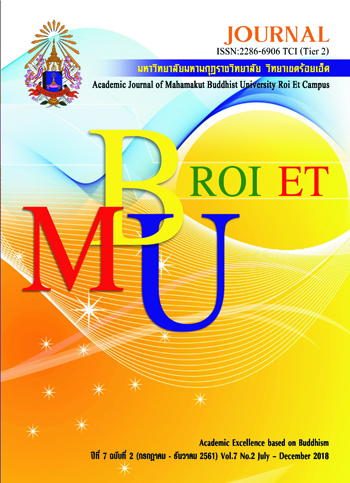The Practice of The Student Caring System in The Saket City School Network under The Office of Primary Education Service, Roi Et Area 1
Main Article Content
Abstract
The purposes of this thematic paper were : 1) to study the practice of the student caring system in the preceding school network under the aforesaid office under it. 2) to compare the practice of the student caring system in the above school network under the same office as classified by respondents’ genders and working experiences, 3) to examine their suggestions for redeeming the practice it in the same school network under it. The sampling groups employed for the research comprised teachers and educational personnel in the target school network in academic year of B.E. 2560, numbering 145 respondents. The tool used for conducting the research was the questionnaire with the content reliability ranging from 0.67 to 1.00 and the reliability at 0.94. Data were analyzed using the computer software package to find frequencies, means, standard deviations, t-tests, F-test (One – way ANOVA), and pair differences by way of Bonferroni ‘s method.
Results of conducting the research have found the following findings:
1) Levels of the practice of the student caring system in the above school network under above mentioned office have had their means at 4.34, 4.13, 4.05, 3.93 and 4.03 respectively in aspects of: having close intimacy as an individual, vetting students, promoting students’ activities, preventing and correcting their misappropriate behaviors, and carrying out their referrals.
2) Levels of means for the practice of the student caring system in the above school network have been found that neither their working experiences less than seven year, between 7 and 15 years nor over fifteen years have shown similarities in aspects of vetting students, promoting students’ activities, preventing and correcting their misappropriate behaviors and carrying out their referral. As for having close intimacy as an individual, it is of stark difference with the statistical significance level at .05. To put it simply, teachers with their working experiences over fifteen years have had higher means than those with theirs less than seven years, with the statistical significance level at .05. As for other pairs, they have proven no differences.
3) Results of examining teachers’ suggestions for boosting the practice of the student caring system in the above school network consist of the following offers. 1) Authorized teachers ought to have close intimacy with students as an individual. Acting as students’ advisers to the classes, teachers must keep students’ personal data such as guardians’ contact phone numbers. 2) The process of vetting students, its school network should draw up a succinct tool as a tangible indicator of students’ conditions to be used for vetting them. 3) Promoting students’ activities, its school network should hold learning activities together for gifted students and risk groups to have each group gain fresh experiences, which further help promote their apt and proper intimacy. 4) Preventing and correcting students’ misappropriate behaviors, teachers have offered that: its school network should: 1) collect ongoing problems and classify them, 2) set up a center for solving problems within each school, allowing one school to set up its own center in accordance with teachers’ skill. For example, there is a teacher having capability of crackdown on drugs at ‘School A’, so let the school be set up and vice versa. 5) Carrying out students’ referral to an outsourcer, teachers should draw up students’ data for referral in details together with carefulness by stressing problematic conditions of referral-related students as the data really are.
Article Details
References
กรมสุขภาพจิต. กระทรวงสาธารณสุข. (2544) . คู่มือครูที่ปรึกษาระบบการดูแลช่วยเหลือนักเรียน. กรุงเทพฯ : โรงพิมพ์ ร.ส.พ..
กุศล ศรีสารคาม. (2557). สถิติเพื่อการวิจัยและการประยุกต์ใช้ SPSS การวิเคราะห์องค์ประกอบโดยใช้โปรแกรม LISREL และ Amos. กาฬสินธุ์ : ประสานการพิมพ์.
เชาวลิต จินดารัตน์. (2551). การดำเนินงานตามระบบดูแลช่วยเหลือนักเรียนของโรงเรียนสังกัดสำนักงานเขตพื้นที่การศึกษาระยองเขต 2. วิทยานิพนธ์ กศ.ม.. มหาวิทยาลัยบูรพา.
ฐานิยา งามศิริ. (2553). การบริหารระบบดูแลช่วยเหลือนักเรียนของโรงเรียนสังกัดสำนักงานเขตพื้นที่การศึกษาฉะเชิงเทราเขต 1. วิทยานิพนธ์ กศ.ม.. มหาวิทยาลัยบูรพา.
บุญชม ศรีสะอาด. (2545). การวิจัยเบื้องต้น. พิมพ์ครั้งที่ 8. กรุงเทพฯ : สุวีริยาสาส์น.
พรพิศ นาถมทอง. (2554). การดำเนินงานตามระบบดูแลช่วยเหลือนักเรียนของโรงเรียนในสังกัดสำนักงานเขตพื้นที่การศึกษามหาสารคามเขต 1. วิทยานิพนธ์การศึกษามหาบัณฑิต. บัณฑิตวิทยาลัย : มหาวิทยาลัยมหาสารคาม.
สมศักดิ์ วรรณศิริ. (2550). การดำเนินงานตามระบบดูแลช่วยเหลือนักเรียนของโรงเรียนที่เปิดสอนในระดับช่วงชั้นที่ 3-4 สังกัดสำนักงานเขตพื้นที่การศึกษามหาสารคามเขต 1วิทยานิพนธ์การศึกษามหาบัณฑิต. บัณฑิตวิทยาลัย : มหาวิทยาลัยมหาสารคาม.
สำนักงานคณะกรรมการการศึกษาขั้นพื้นฐาน. (2546). คู่มือการบริหารจัดการระบบการดูแลช่วยเหลือนักเรียนเพื่อพัฒนาคุณภาพและแก้วิกฤตสังคม. กรุงเทพฯ : ชวนพิมพ์.
สำนักงานคณะกรรมการการศึกษาขั้นพื้นฐาน. (2547). การใช้เกณฑ์มาตรฐานของโรงเรียน. กรุงเทพฯ : โรงพิมพ์คุรุสภาลาดพร้าว.
สำนักงานคณะกรรมการการศึกษาแห่งชาติ. (2542). พระราชบัญญัติการศึกษาแห่งชาติ พ.ศ. 2542. กรุงเทพฯ : โรงพิมพ์อักษรไทย.
สุธน มูลตรีศรี. (2553). การศึกษาปัญหาการดำเนินงานจัดระบบดูแลช่วยเหลือนักเรียนของครูโรงเรียนประถมศึกษาในเขตอำเภอเมืองสระแก้วสังกัดสำนักงานเขตพื้นที่การศึกษาสระแก้วเขต 1. วิทยานิพนธ์ กศ.ม.. ชลบุรี : มหาวิทยาลัยบูรพา.


